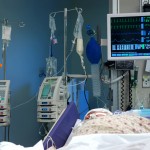
Ventilator-associated pneumonia (VAP) is a serious lung infection in patients who already critically ill. VAP is reported to develop in 6-52% of ventilated patients and have an attributable mortality of 10%. Studies have suggested that oral hygiene measures involving mouthrinses, gels , swab, toothbrush, or combination, with suction of secretions may reduce VAP risk.
The aim of this Cochrane review update was to assess the impact of oral health measures on the incidence of VAP in critically ill patients receiving mechanical ventilation in intensive care.
Methods
Searches were conducted in the Cochrane Oral Health’s Trials Register, the Cochrane Central Register of Controlled Trials (CENTRAL), Medline, Embase, LILACS BIREME Virtual Health Library, CINAHL EBSCO, the VIP Database, the US National Institutes of Health Trials Registry (ClinicalTrials.gov) and the World Health Organization International Clinical Trials Registry Platform. There were no restrictions on language or date of publication. Randomised controlled trials (RCTs) evaluating the effects of oral health measures in critically ill patients receiving mechanical ventilation for at least 48 hours were considered. Standard Cochrane methodological approaches were used with dichotomous outcomes reported as risk ratio (RR) and continuous outcomes as mean difference (MD). Random-effects meta-analysis was used to combine studies.
Results
- 40 RCTs involving 5675 patients were included.
- 31 trials were considered to be at high risk of bias, 2 at low risk and the remainder at unclear risk.
- Comparisons evaluated included:-
- Chlorhexidine versus placebo/usual care, with or without toothbrushing (13 studies).
- Chlorhexidine versus other oral care agents (including potassium permanganate, ozonated water , miswak, Nanosil, hydrogen peroxide (7 studies).
- Toothbrushing versus no toothbrushing (in addition to usual care) (8 studies).
- Powered toothbrushing versus manual toothbrushing (1 study).
- Other oral care agents, including saline, bicarbonate, povidone iodine,triclosan, furacilin, Listerine, Biotene Oral Balance, hydrogen peroxide, potassium permanganate (17 studies).
CHX mouthrinse or gel, as part of oral health measures
- Probably reduces the incidence of VAP compared to placebo or usual care from 26% to about 18%; RR =0.67 (95%CI; 0.47 to 0.97) [Moderate-certainty evidence 13 RCTs (1206 patients)]. A number needed to treat for an additional beneficial outcome (NNTB) of 12 (95%CI; 7 to 128).
- Shows no evidence of:-
- A difference between interventions for the outcomes of mortality; RR = 1.03 (95%CI; 0.80 to 1.33); [9 RCTs, 944 patients; moderate-certainty evidence].
- A reduction in duration of mechanical ventilation; MD = -1.10 days (95%CI; -3.20 to 1.00 days) [4 RCTs, 594 patients; very low-certainty evidence] or
- duration of intensive care unit (ICU) stay; MD = -0.89 days (95%CI; -3.59 to 1.82 days) [5 RCTs, 627 patients; low-certainty evidence].
Toothbrushing (± antiseptics)
- Compared to oral care without toothbrushing (± antiseptics) may reduce the incidence of VAP; RR= 0.61, (95%CI; 0.41 to 0.91) [5 RCTs, 910 participants; low- certainty evidence].
- May reduce the duration of ICU stay; MD= -1.89 days (95%CI; -3.52 to -0.27 days) [ 3 RCTs, 749 patients; very low certainty evidence].
- Low-certainty evidence did not show a reduction in mortality; RR = 0.84 (95%CI; 0.67 to 1.05) [5 RCTs, 910 participants] or duration of mechanical ventilation; MD= -0.43 (95%CI; -1.17 to 0.30) [ 4 RCTs, 810 patients].
Conclusions
The authors concluded: –
Chlorhexidine mouthwash or gel, as part of OHC, probably reduces the incidence of developing ventilator-associated pneumonia (VAP) in critically ill patients from 26% to about 18%, when compared to placebo or usual care. We did not find a difference in mortality, duration of mechanical ventilation or duration of stay in the intensive care unit, although the evidence was low certainty. OHC including both antiseptics and toothbrushing may be more effective than OHC with antiseptics alone to reduce the incidence of VAP and the length of ICU stay, but, again, the evidence is low certainty. There is insufficient evidence to determine whether any of the interventions evaluated in the studies are associated with adverse effects.
Comments
This Cochrane review is an update of the previous version published in 2016 (Dental Elf – 31st Oct 2016). There has been some modification of the inclusion criteria with this version and 9 new RCTs were identified but a number studies included in the previous version have been excluded with the result that the number of included studies overall has increased to 40 (previously 38). In the 2016 version of the review no evidence of benefit from toothbrushing patients in intensive care was found but this update includes low‐certainty evidence that it may reduce the incidence of VAP and very low certainty evidence that it may reduce the length of ICU stay. In the discussion the authors highlight a number of variables that may influence the outcomes, the number of episodes of oral health care (‘dose’), a potential ‘Hawthorne effect’ because of study participation and variability in the diagnosis of VAP as there is currently no accepted gold standard. The authors also call for more consistent use of the CONSORT statement for reporting of RCTs on this topic.
Links
Primary Paper
Zhao T, Wu X, Zhang Q, Li C, Worthington HV, Hua F. Oral hygiene care for critically ill patients to prevent ventilator-associated pneumonia. Cochrane Database Syst Rev. 2020 Dec 24;12:CD008367. doi: 10.1002/14651858.CD008367.pub4. PMID: 33368159.
Other references
Dental Elf – 31st Oct 2016
Dental Elf -Ventilator Associated Pneumonia blogs
